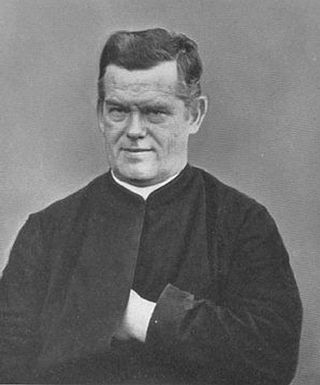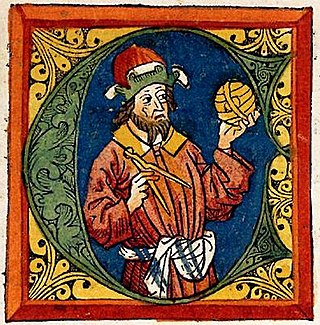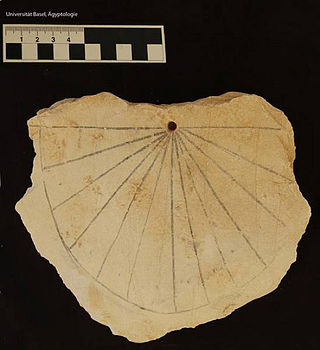
Hipparchus was a Greek astronomer, geographer, and mathematician. He is considered the founder of trigonometry, but is most famous for his incidental discovery of the precession of the equinoxes. Hipparchus was born in Nicaea, Bithynia, and probably died on the island of Rhodes, Greece. He is known to have been a working astronomer between 162 and 127 BC.

An hour is a unit of time historically reckoned as 1⁄24 of a day and defined contemporarily as exactly 3,600 seconds (SI). There are 60 minutes in an hour, and 24 hours in a day.
Nabu-ri-man-nu was a Chaldean astronomer and mathematician.

A water clock or clepsydra is a timepiece by which time is measured by the regulated flow of liquid into or out from a vessel, and where the amount of liquid can then be measured.
Otto Eduard Neugebauer was an Austrian-American mathematician and historian of science who became known for his research on the history of astronomy and the other exact sciences as they were practiced in antiquity and the Middle Ages. By studying clay tablets, he discovered that the ancient Babylonians knew much more about mathematics and astronomy than had been previously realized. The National Academy of Sciences has called Neugebauer "the most original and productive scholar of the history of the exact sciences, perhaps of the history of science, of our age."

Christian Ludwig Ideler was a German chronologist and astronomer.
An ecclesiastical new moon is the first day of a lunar month in an ecclesiastical lunar calendar. Such months have a whole number of days, 29 or 30, whereas true synodic months can vary from about 29.27 to 29.83 days in length. Medieval authors equated the ecclesiastical new moon with a new crescent moon, but it is not a phase of the true moon. If the ecclesiastical lunar calendar is accurate, the ecclesiastical new moon can be any day from the day of the astronomical new moon or dark moon to two days later. The ecclesiastical calendar valid for the Julian and Gregorian calendar are described in detail by Grotefend, Ginzel and in the Explanatory Supplement to The Astronomical Ephemeris.
Seleucus of Seleucia was a Hellenistic astronomer and philosopher. Coming from Seleucia on the Tigris, Mesopotamia, the capital of the Seleucid Empire, or, alternatively, Seleukia on the Erythraean Sea, he is best known as a proponent of heliocentrism and for his theory of the causes of tides.

Franz Xaver Kugler was a German chemist, mathematician, Assyriologist, and Jesuit priest.

The Canon of Kings was a dated list of kings used by ancient astronomers as a convenient means to date astronomical phenomena, such as eclipses. For a period, the Canon was preserved by the astronomer Claudius Ptolemy, and is thus known sometimes as Ptolemy's Canon. It is one of the most important bases for our knowledge of ancient chronology.

The decans are 36 groups of stars used in the ancient Egyptian astronomy to conveniently divide the 360 degree ecliptic into 36 parts of 10 degrees each, both for theurgical and heliacal horological purposes. The decans each appeared, geocentrically, to rise consecutively on the horizon throughout each daily Earth rotation. The rising of each decan marked the beginning of a new decanal "hour" of the night for the ancient Egyptians, and they were used as a sidereal star clock beginning by at least the 9th or 10th Dynasty.

Babylonian astronomy was the study or recording of celestial objects during the early history of Mesopotamia. The numeral system used, sexagesimal, was based on sixty, as opposed to ten in the modern decimal system. This system simplified the calculating and recording of unusually great and small numbers.

MUL.APIN is the conventional title given to a Babylonian compendium that deals with many diverse aspects of Babylonian astronomy and astrology. It is in the tradition of earlier star catalogues, the so-called Three Stars Each lists, but represents an expanded version based on more accurate observation, likely compiled around 1000 BCE. The text lists the names of 66 stars and constellations and further gives a number of indications, such as rising, setting and culmination dates, that help to map out the basic structure of the Babylonian star map.

The ancient Egyptians were one of the first cultures to widely divide days into generally agreed-upon equal parts, using early timekeeping devices such as sundials, shadow clocks, and merkhets . Obelisks were also used by reading the shadow that they make. The clock was split into daytime and nighttime, and then into smaller hours.
Friedrich Karl Ginzel was an Austrian astronomer.

A sundial is a device that indicates time by using a light spot or shadow cast by the position of the Sun on a reference scale. As the Earth turns on its polar axis, the sun appears to cross the sky from east to west, rising at sun-rise from beneath the horizon to a zenith at mid-day and falling again behind the horizon at sunset. Both the azimuth (direction) and the altitude (height) can be used to create time measuring devices. Sundials have been invented independently in every major culture and became more accurate and sophisticated as the culture developed.

Unequal hours are the division of the daytime and the nighttime into 12 sections each, whatever the season. They are also called temporal hours,seasonal hours,biblical or Jewish hours, as well as ancient or Roman hours. They are unequal duration periods of time because days are longer and nights shorter in summer than in winter. Their use in everyday life was replaced in the late Middle Ages by the now common ones of equal duration.
The Aramaic Uruk incantation acquired 1913 by the Louvre, Paris and stored there under AO 6489 is a unique Aramaic text written in Late Babylonian cuneiform syllable signs and dates to the Seleucid Empire ca. 150 BCE. The finding site is the reš-sanctuary in the ancient city of Uruk (Warka), therefore the label “Uruk”. Particular about this incantation text is that it contains a magical historiola which is divided up into two nearly repetitive successive parts, a text genre that finds its continuation in the Aramaic magical text corpus of late antiquity from Iraq and Iran, most prominently in incantation bowls and Mandaic lead rolls.
This is a bibliography of water clocks.
Danna (Sumerian) or Beru (Akkadian) is a word denoting a unit of time consisting of two hours. There were twelve Danna in a day. Danna were first used around 2400 BC.











